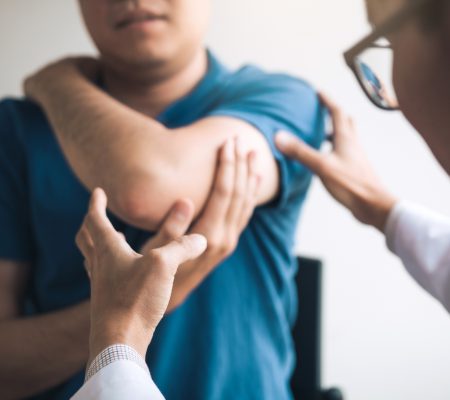10 Tips for Preventing Elbow Injuries
You never realize how much you use your elbow until it’s injured! Unfortunately, elbow injuries are all too common, but you can follow some simple tips for preventing elbow injuries.
Elbow injuries can affect people of all ages—older adults after a fall, and even youth athletes who’ve thrown a few (hundred) too many pitches. The elbow is innately involved with everyday tasks like eating, brushing our teeth, picking up our children, walking the dog, or throwing a ball.
Composed of several small joints that connect our upper arm to our forearm, the elbow is supported by a network of ligaments, tendons, and muscles—all of which can be injured. Regardless of how it occurs, an elbow injury sidelines you from many daily tasks and even your favorite activities.
Common Elbow Injuries
Some of the most common traumatic injuries to the elbow include fractures, dislocations, and soft tissue injuries. These injuries often occur during a slip and fall onto an outstretched hand or from a direct blow to the elbow, usually ending up with a trip to the emergency room.
Treatment for elbow damage normally includes a period of immobilization and rest, followed by a structured rehabilitation process led by a  physical therapist. The Orthopaedic Hospital of Wisconsin physical therapist Nico Olson-Studler, PT, DPT advises, “with the proper guidance from your physical therapist, regularly performing targeted stretches and exercises will help you return to normal after an elbow injury.” Physical therapists play an integral role in managing elbow injuries as they are familiar with the complex anatomy and mechanics of the joint and the recovery process.
physical therapist. The Orthopaedic Hospital of Wisconsin physical therapist Nico Olson-Studler, PT, DPT advises, “with the proper guidance from your physical therapist, regularly performing targeted stretches and exercises will help you return to normal after an elbow injury.” Physical therapists play an integral role in managing elbow injuries as they are familiar with the complex anatomy and mechanics of the joint and the recovery process.
Elbow injuries can also be commonly caused by repetitive overuse. For example, keyboarding and mousing during an 8-hour workday, gripping and pulling when raking the yard, or throwing a baseball at high speeds during daily team practice can lead to an acute elbow injury.
Olson-Studler explains, “When we ‘overdo-it’ with these seemingly harmless activities, the repetitive nature of these tasks over time places greater demand on the soft tissues than they can withstand, leading to pain and dysfunction.”
Lateral epicondylitis, more commonly known as “Tennis elbow” and medial epicondylitis, “Golfer’s elbow,” are forms of tendinitis that develop when the tendons attached to the elbow become overworked, inflamed, and painful. Other elbow injuries that may develop from overuse involve compression of the nerves in the elbow. Cubital tunnel syndrome occurs with irritation of the ulnar nerve, causing symptoms of pain, numbness, and tingling along the forearm that often extends down into the ring and pinky fingers. More advanced cases of this elbow injury may include weakness in the forearm and hand.
Fortunately, there are several things you can do to reduce your chances of sustaining an elbow injury. OHOW’s Calvin Thomas, PT, DPT, OCS provides his top 10 tips for preventing elbow injuries.
1. Watch your Step
Prevent elbow injuries from a fall by using walking sticks, an assistive device (i.e., cane or walker), or taking careful steps when walking on uneven and slippery surfaces. It’s imperative to have good balance when you’re walking outdoors or going up and down stairs. Always use a hand railing for support when available and take an illuminated path when it’s dark out.
2. Protect Your Joints During Activity
If participating in higher-level winter activities such as skiing, snowboarding, or ice skating, we encourage you to wear the proper gear. For many of these activities, it’s a good idea to wear a helmet and consider elbow pads and wrist guards to protect your elbows from injury if you reach out to catch a fall.
3. Maintain Good Posture
Prevent elbow injuries from compensatory overuse by maintaining good posture and proper body mechanics with everyday activities. Also, consider your workstation setup to optimize your ergonomics, as elbow pain can develop with prolonged daily computer use with poor posture.
4. Seek Early Physical Therapy
If you’re experiencing mild-to-moderate elbow pain symptoms, it’s best to get checked out by a trained professional to prevent a worsening of your symptoms or a chronic pain condition. Seek more immediate medical attention if your elbow pain symptoms are severe.
5. Prioritize Physical Activity
Stay active by regularly performing strengthening exercises for your arm muscles. Strength training will help you perform gripping, reaching, lifting, and carrying activities with ease, reducing the likelihood of elbow injuries. Boost your elbow health by staying physically fit with regular aerobic exercise and stretches.
6. Take Regular Breaks to Prevent Elbow Injuries
Prevent overuse injuries to your elbow and all body parts by pacing repetitive activities, including sports, recreation, work duties, and household chores. Elbow pain will often subside with adequate rest, ice, and protection of your injured arm. Avoid pushing through an injury, as it may lead to more significant damage or prolonged recovery. Take intentional breaks in your daily routine; for example, space out a 2-hour chore into 30-minute intervals.
7. Use Your Non-Dominant Hand
If you tend to rely on your dominant hand for pushing, pulling, and gripping, try using your non-dominant hand or both hands to perform tasks instead. Switching up your use will take the strain off of your dominant arm and prevent injury when using proper body mechanics.
8. Seek Advice on Proper Form
If your elbow pain seems related to sports activities, such as playing tennis or golf, the mechanics of your swing may be to blame. Consider getting lessons from a trained professional to assess your swing technique or determine if you are using the right-sized equipment. Not only will you prevent elbow injuries, but you might end up improving your game as well!
9. Practice Good Self-Care
Part of preventing elbow injuries is learning not to overextend your joints with taxing repetitive motions, especially with one arm. You may find relief from a professional massage, performing self-massage, or applying a hot pad onto your aching arm muscles. Mindfulness and meditation also help your muscles relax and allow you to shift your attention away from the pain you may be experiencing.
10. Be Patient with Recovery from an Elbow Injury
If you’ve experienced an elbow injury, seek medical advice from your physician or physical therapist to diagnose your injury and help identify the next steps in your recovery. The body is very good at healing itself, but it takes time. Set yourself up for success by giving your body the proper sleep, nutrition, hydration, and exercise to optimize your recovery. If moderate-to-severe symptoms persist beyond a few weeks, your doctor may recommend alternative forms of treatment to help address your pain concerns.
It’s essential to keep these tips in mind to avoid undue stress and injury to our elbows. The Orthopaedic Hospital of Wisconsin physical therapist Calvin Thomas, PT, DPT, OCS says, “We hope these tips help you to avoid an elbow injury this winter. If you should hurt yourself, we’re prepared to help you get back to the winter activities that you love as quickly as possible.”
Winter is a prime time for preventing elbow injuries. Be sure to check your driveway for ice that may have formed overnight, take plenty of breaks when shoveling, and plan a clear path when out skiing, ice skating, or walking across snow. At the Orthopaedic Hospital of Wisconsin, we’re here to help you stay healthy and engaged in your favorite activities all year round. Request an appointment with one of our skilled physical therapists if you have any further questions about preventing elbow injuries.


